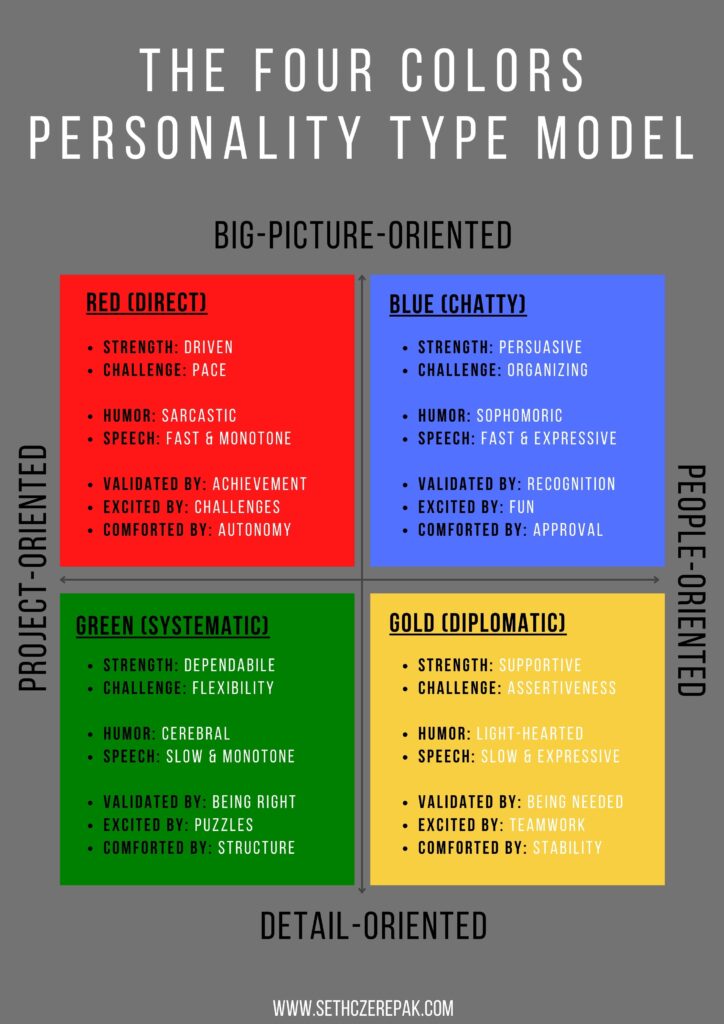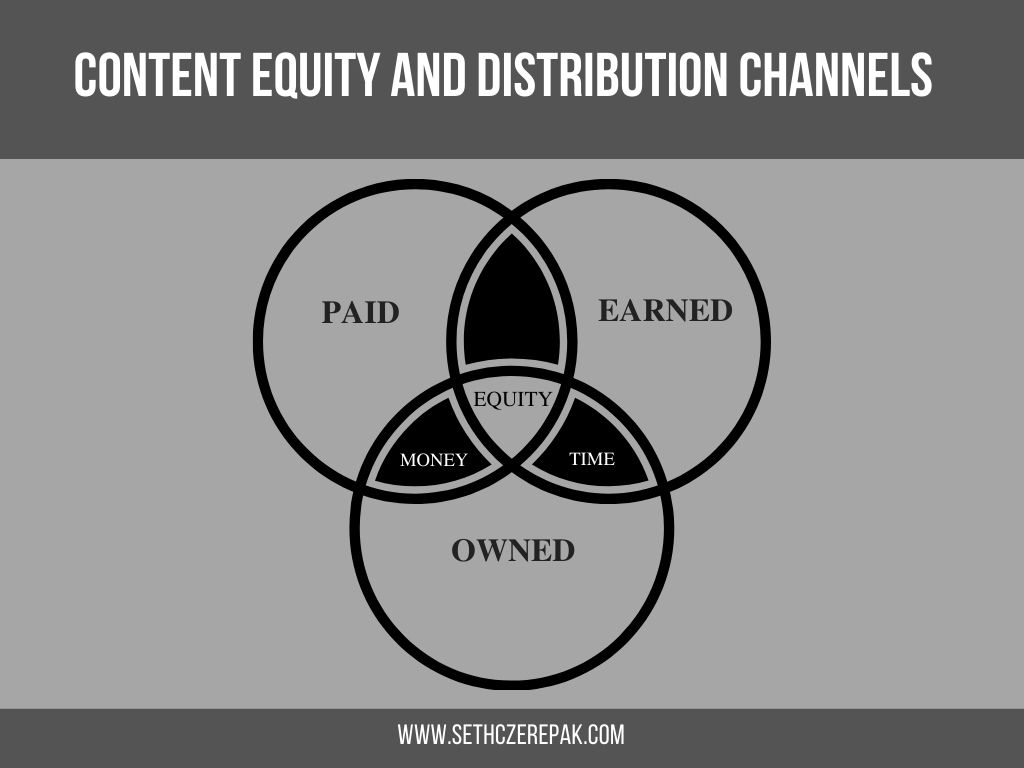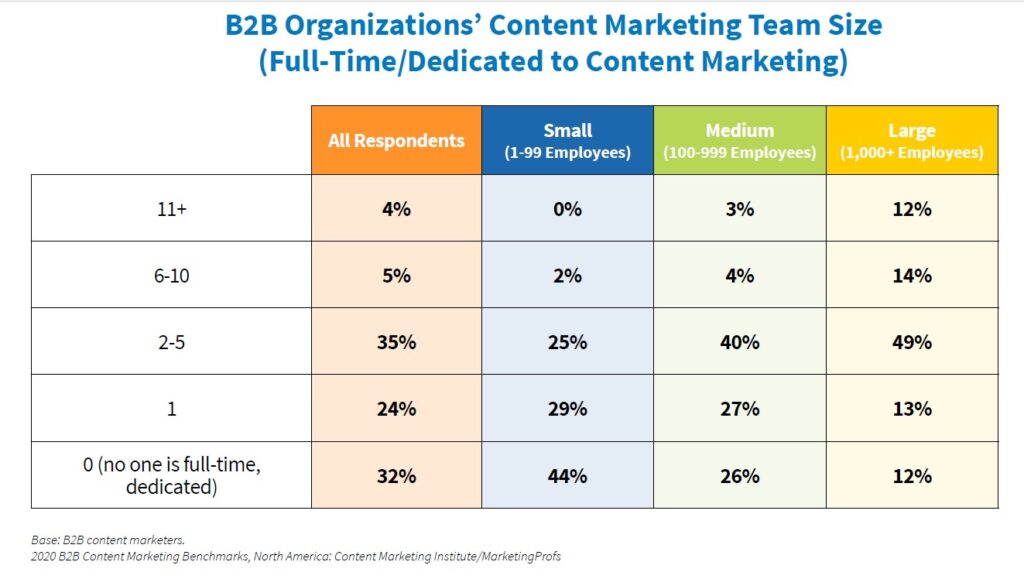Content Marketing Strategy and Best Practices
Content Marketing: a type of marketing focused on creating and distributing relevant, valuable information with the goal of attracting a clearly-defined audience and engaging them to take a specific action.
Topics Covered in This Article
Your Content Marketing Strategy Blueprint
A good Content Marketing Strategy starts with a good content marketing blueprint. This blueprint will include your content marketing goals and KPIs, buyer persona(s), content distribution plan, your content creation, and publishing plan, and internal promotion strategy.
Starting with a written content marketing blueprint increases your odds of long-term success. It also gives you an objective way to measure your progress and plan improvements.
In this article, I’ll introduce you to our signature eight-step content marketing blueprint. This blueprint is based on The Antifragile Sales System. I started designing this system back in the early 2000s while working as a call center manager. I’ve also been using, testing, and refining this blueprint since 2009 when I started my freelance copywriting career.
I’ve used this simple eight-step blueprint to build complex multi-step content marketing systems (offline and online) for hundreds of clients. In 2012, Copywriting Legend Dan S Kennedy reviewed and endorsed this system. I’ve included his endorsement below for those interested in reading it. The rest of this article will introduce the eight steps of the Antifragile Content Marketing Strategy along with a brief explanation of each.
– Article Continues Below Endorsement –
Expert Endorsement
Dan S Kennedy on The Antifragile Sales System
“Seth Czerepak has accomplished a Herculean purpose with The Antifragile Sales System. He has taken some of the most sophisticated aspects of writing to influence, motivate, persuade and sell and made them accessible and pragmatically useful, nearly to the point of fill in the blank systemization. It is relatively easy to systemize the making of a sub sandwich in 1,000 Subway® shops or the installation of a car muffler in 1,000 Midas Muffler® shops. It is far, far, far from easy to systemize the crafting of persuasive copy. I know. I have been a professional direct-response copywriter for 40+ years, and raised myself to top income in the field, routinely commanding upwards from $100,000.00 per project, earning a 7-figure annual income from fees and royalties, with over 85% of all clients repeating with me. Further, I have taught copywriting to writers, direct marketers and business owners via seminars and workshops, home study and online courses, and one to one coaching. There are easier things to teach. Seth has covered essential bases and delved into advanced and groundbreaking territory as well.”
The Eight Step Antifragile Content Marketing Strategy
I’ll explain each step below as we unpack them one at a time. Keep in mind, however, that this article is just a summary of how a content marketing strategy helps you plan, document, implement, measure, and improve your content marketing strategy. Like anything else worth doing, a successful content marketing strategy demands hard work, patience, sacrifice, and critical thinking.
This is why smart companies invest five or six figures a year into hiring content marketing agencies or building their own content marketing departments. If you’re ready to talk to us about using this content marketing strategy to grow your business, I’ve left an invitation at the bottom of this article.
Your Content Marketing Goals
The first step in building an effective content marketing strategy is to establish your content marketing goals. This gives you a standard against which to measure your progress.
This is especially important when it comes time to plan, document, and measure your Content Marketing KPIs. Most importantly, it is the secret to persuading others to continue supporting your content marketing efforts or (if you’re running your own agency) paying for your services.
Your content marketing goals should be:
A good way to see if your content marketing goals match this formula is to try breaking them down into smaller milestones. For example, let’s assume you set this goal:

“Our goal is to increase our total number of qualified inbound leads.“
Can you break this goal down into smaller milestones? No, you can’t. It doesn’t define a specific number of leads and it doesn’t give you a definite deadline for reviewing your progress. However, let’s assume you set a goal like this:
“Our goal is to increase our number of qualified inbound leads from 20 a month to 200 a month by January 1rst 2025.“
Can you break this goal down into smaller milestones? Yes, you can. Simply take your end goal of increasing your inbound leads from twenty a month to two hundred a month and cut it into two six-month milestones. Check out my article on Content Marketing Goals and KPIs for details on how to do this. Let’s move on to the second step of your Content Marketing Strategy.
Your Content Marketing Audience(s)
Buyer Persona: a semi-fictitious profile of your ideal customer based on data and research of one or all of the following… 1) your existing customers, 2) your competitors’ audience(s), 3) the demographics of your niche or industry.
In my experience, most content marketing strategies fail because of a poorly or partially defined target audience. This is why the second step of your content marketing strategy is to create a profile of your target audience. Content marketing experts call this profile your “buyer persona.”
The more thoroughly defined your buyer’s persona is, the more focus, clarity, and momentum you’ll build as you move through the other steps of your content marketing strategy.
Benefits of Using a Buyer Persona

Source: boardview.io blog on buyer persona statistics.
These statistics prove that if you take your time with this step you’ll be rewarded with more leads, higher quality prospects, shorter sales cycles, and higher sales revenue. I unpack the VQ Success Buyer Persona Blueprint one step at a time in my article on How to Create a Buyer Persona. For the sake of this article, here is a quick summary of the B2C and B2B Buyer Persona templates we use:
B2C Buyer Persona Template
© 2024 VQ Success Content Marketing Services – B2C Buyer Persona
B2B Buyer Persona Template
© 2024 VQ Success Content Marketing Services – B2B Buyer Persona
Once you’ve completed the primary checkpoints for your buyer’s persona(s), there’s one more very important step I recommend. This step helps tremendously when it comes time to create compelling content marketing messages and to choose your distribution channels.
Check out my full article on How to Create a Buyer Persona to find out what this step is and why it’s essential. Let’s move on to the third step of your Content Marketing Strategy.
Your Content Distribution Channels
Content Distribution Channel: a path or route used to deliver content marketing messages to a clearly-defined buyer persona. The channel can be as short as a direct exchange between the organization and the customer or can involve the use of content distribution platforms like social media sites or search engines.
Once you’ve thoroughly defined your goal(s) and your buyer persona(s), the next step in your content marketing strategy is to choose your distribution channels. These are places where you’ll deliver your marketing messages to potential readers.
You want to pick the content distribution channels which will make the biggest impact in helping you achieve your content marketing goal. I’ll show you three simple rules for doing this in a moment. First, let’s define the basic types of content distribution channels:
Types of Content Distribution Channels
These content distribution channels can be digital or offline. The important point is that you pick channels where you can reach the audience defined by your buyer’s persona(s) and where you have the greatest opportunity to achieve your content marketing goal(s). Here are three rules that will help you do that:
Content Distribution Rule #1: Equity
This rule is all about building “Content Equity,” which I explain in the article on the Benefits of a Content Marketing Strategy. The PRIMARY goal of a content marketing strategy is to use Paid channels and Earned channels to increase the strength and sustainability of your Owned channels.
This means that any content you publish on paid or earned platforms should be used to drive visibility to your website, your email newsletters, your direct mail catalogs, and other owned channels. The more valuable you make your owned content marketing channels, the more long-term success you can create, and at a fraction of the cost.
Content Distribution Rule #2: Audience
Statements like this are based on the outdated idea that marketing is about getting your ads in front of as many eyeballs as possible. This is a quick way to burn through your marketing budget with little or no results.
According to a 2016 Study from Nielsen’s Digital Ad Ratings, about 48% of all online ad budgets were wasted because they were not reaching the right audience. The most important question is whether a content distribution channel gives you targeted access to your buyer’s persona.
If it does, and if you can use it to strengthen one (or more) of your owned channels, put that content distribution channel on your shortlist. If not, leave it off. Never mind how popular it is or how many of your competitors are marketing there.
Content Distribution Rule #3: Credibility
This rule is all about perceived credibility. Where you publish your content has a tremendous impact on how credible you appear to your audience. Most marketers would agree that advertising on a spam site makes your brand look less credible. Consider the credibility differences between all your content distribution channels, and shortlist your most credible content distribution channels.
All other things being equal, I’m sure you’d feel better about hiring a lawyer you met at a fundraiser dinner than the one you met at a roadside bar. I’m also sure you’d prefer that your daughter meet her future husband in an Art Museum or at Church as opposed to a nightclub.
The same principle applies when choosing your content distribution channels. Where you show up has a tremendous impact on how credible you appear to your audience. That’s why our final rule is to choose content distribution channels where you’ll appear credible simply for showing up there.
Sample Content Distribution Channel Shortlist
Applying the above three rules should give you a shortlist of highly relevant, credible content distribution channels, like this:

This may seem like a small list, but remember, our goal is relevance and credibility. Not volume. Start with a list of channels where you have the highest probability of reaching your ideal customers and where you can best measure and improve your Content Marketing KPIs. You can always expand to other channels once you’ve built up momentum.
While planning and documenting your content marketing strategy, remember that an owned channel is a channel where you control the content, audience access, and means of distribution. This means that pages on Social Media websites don’t count. Your Social Media pages are owned by the Social Media company that hosts those pages. This could change at some point in the future, in which case I’ll update this article.
However, as long as Social Media websites have the legal right to shadowban, suspend, or even delete your accounts, it’s a risk to treat your Social Media accounts and pages as owned content distribution channels.
Once you’ve defined and documented your most relevant and credible content distribution channels, it’s time to create your content distribution schedule. This is the fourth step of your Content Marketing Strategy.
Your Content Distribution Schedule
Your content marketing and distribution schedule is a practical to-do list for your content creation team. It tells you and your team when (or how often) to create and distribute your content. Some content marketing agencies organize their content distribution schedule according to distribution channels. Others organize it according to content type. In the example below, we’ll organize your content marketing and distribution schedule according to the Five Stages of The VQ Success Buyer’s Journey.
Once you’ve created your Stage #3 Sales Page and your Stage #4 Order Page, you only need to freshen them up based on what you learn from tracking your Content Marketing KPIs (which we’ll discuss later). This leaves you with only two new pieces of content to create every month–your SEO Article, and your Quarterly (customer) Newsletter. I’ll highlight these pieces of seed content in the examples below:
Buyer’s Journey Stage #1
Content Goal: persuade the prospect to sign up for Stage #2 educational emails.
Seed Content: monthly SEO Article (10,000 words) starting out with Stage #1 message and progressing to Stage #2.
Monthly Stage #1 Content
Weekly Stage #1 Content
Daily Stage #1 Content
Buyer’s Journey Stage #2
Content Goal: persuade the prospect to sign up for Stage #3 sales emails (send to Stage #3 sales page after sign up).
Seed Content: monthly SEO Article (10,000 words) starting out with Stage #2 message and progressing to Stage #3.
Monthly Stage #2 Content
Weekly Stage #2 Content
Daily Stage #2 Content
Buyer’s Journey Stage #3
Content Goal: persuade the prospect to visit Stage #4 order page and become a customer.
Seed Content: Stage #3 Sales Page (including text and video content, customer reviews, etc.).
Monthly Stage #3 Content
Weekly Stage #3 Content
Daily Stage #3 Content
Buyer’s Journey Stage #4
Content Goal: persuade the prospect to visit Stage #4 order page and become a customer.
Seed Content: Stage #4 Order Page (including text and video content).
Monthly Stage #4 Content
Weekly Stage #4 Content
Buyer’s Journey Stage #5
Content Goal(s): persuade the customer to write a positive review, make another purchase, or refer a colleague.
Seed Content: Quarterly Customer Newsletter.
Monthly Stage #5 Content
Weekly Stage #5 Content
Your Content Marketing Strategy So Far
Congratulations! You’re now halfway into your content marketing strategy. This is where the planning stage of your content marketing strategy ends and the execution stage starts. Here’s a quick recap of the Antifragile Content Marketing Strategy and the steps we’ve completed so far:
Your Content Creation Plan
By now, you have a clearly defined buyer’s persona. You have a list of content distribution channels. You have a well-documented content distribution schedule. This is the stage where you might want to hire a content marketing agency. By the time you’ve read this, you’ll know whether this is the right move for your company.
The secret to making this plan work is to assign a percentage of your project timeline to each of the three stages of your content creation plan. Here’s a formula that’s worked very well for me and for the teams of content writers I’ve managed over the years.
This formula gives your content creation team sufficient time and compensation to deliver a high-quality piece of content. Here’s a brief summary of each step (you’ll find more details on each step in our Content Creation Plan article).
Stage #1: Plan Your Content
The secret to creating great marketing content is to start with an idea, not just a topic. In his book, A Writer’s Coach, (Chapter I: Method) author Jack Hart brilliantly explains the difference between a topic and an idea. Simply put, topic-driven content merely informs your reader about a subject. The internet is loaded with topic-driven content, and it’s getting harder to stand out if that’s all you’re publishing.
On the other hand, idea-driven content changes the way your reader thinks about the subject. Your content should introduce an idea that influences your reader’s perception of:
The idea is to start with a topic that’s relevant to the stage of the buyer’s journey you expect your prospect to be in when they find your content. Once you have your topic, your next job is to find an idea that changes the way your prospect thinks about the topic. Since the topic of idea generation is beyond the scope of this article, I’ll refer you to our explain these four items in our Buyer’s Journey vs Customer Journey article.
Stage #2: Draft Your Content
This is where you take the research data and the outline you created during your planning stage, and hand it to someone who has the focus and drive to hammer out your first draft. The secret to this stage is to have ONE PERSON write the content and not bring in anyone else until the first draft is done. Your writer should not worry about typos, proper grammar, or any of those last stage details.
If you involve more than one person at this stage or if your writer tries to write and polish at the same time, your project will quickly become pear-shaped and before you know it, you’ll be staring down your deadline with nothing but a file of disorganized ideas to work with. We’ll discuss how to build and manage a content marketing team later in this article, including when you should (or should not) have multiple people working on the project.
Stage #3: Polish Your Content
Once your first draft is done, the final step is to put your content through three rounds of edits. Each round has a different purpose, and it’s important not to mix them up. I’ll explain later how to leverage the strengths of your content marketing team members at this stage.
Round #1: Edit for Clarity
Have someone other than your content writer go through your first draft and remove or recommend a revision for anything that is:
Ideally, this should be done by someone who can see your content from the perspective of your Buyer Persona. In my experience, people like this are hard to find and I’ll explain why later. I also suggest checking out A Writer’s Coach by Jack Hart and studying the chapters on Force, Brevity, and Clarity and applying his techniques to this stage of your editing.
Round #2: Edit for Style
By now, you should be working with a clear, credible, interesting, and authentic piece of content. If you’ve done a good job so far, this is where your content will really come to life. In my experience, this round of edits should be done by the person who wrote your content.
I suggest you check out A Writer’s Coach by Jack Hart and study the chapters on Rhythm, Color, and Voice for more details on editing for style. I also cover this topic in great detail in my free copywriting course 10 Persuasive Copywriting Techniques. As long as you’ve used someone else for the Clarity round, you should end up with something remarkable by the time they’re done.
Round #3: Edit for Typos
The final round of editing is simple. Have someone who is very, very detail-oriented check it for mechanical errors. There should be no additional editing for clarity or style at this stage. Allowing or encouraging this kind of editing will slow down your project, and the end result will not be as polished. In my experience, this is hard for some people to resist. But the ability to resist it and finish your content on time is the mark of a truly professional writing team.
Your Content Marketing Team
You have two options for implementing your content marketing strategy. First, you can hire a content marketing agency. We’ll discuss this option in our article on the Benefits of a Content Marketing Strategy.
The other option is to build your own in-house content marketing team, which we’ll talk about right now.
According to 2020 research from CMI, the average content marketing team size (for B2B and B2C organizations) is between two and five people. In my experience, the ideal content marketing team includes four members, each with their own set of specialized skills, strengths, and personality traits. I’ll start by summarizing each of these team members and their respective traits. Then we’ll summarize how your content marketing team might implement your content marketing strategy.
Team Member #1: Writer
Your WRITER is responsible for getting the bulk of your writing done and done on time. In The Antifragile Sales System, we call this the “Red” personality and describe them using the following ten personality traits:
NOTE: The DISC model calls this the “Dominant” personality type.
Team Member #2: Salesperson
Your SALESPERSON is primarily responsible for making sure that content is relevant and relatable to your buyer’s persona. In The Antifragile Sales System, we call this the “Blue” personality, and describe them using the following ten personality traits:
NOTE: The DISC model calls this the “Influential” personality type.
Team Member #3: Manager
Your MANAGER is primarily responsible for making sure that your content marketing team works well together. In The Antifragile Sales System, we call this the “Gold” personality, and describe them using the following ten personality traits:
NOTE: The DISC model calls this the “Supportive” personality type.
Team Member #4: Editor
Your EDITOR is primarily responsible for making sure that your content is credible, well-organized, and error-free. In The Antifragile Sales System, we call this the “Green” personality, and describe them using the following ten personality traits:
NOTE: The DISC model calls this the “Compliant” personality type.
Summary of Your Content Marketing Team

Picking Your Writer
Ideally, your writer should be someone who can quickly grasp complex ideas and put them into words. They should also be interested in the subjects they’ll be writing about and have some real-world experience with the topic. Find someone who is either a member of the demographic you’ve identified in your buyer’s persona or who has real-life experience communicating with them. Finally, they should be someone who communicates well with your salesperson. This will ensure that their writing is as relevant and authentic to your buyer’s persona as possible.
Picking Your Salesperson
This person should literally be a salesperson at your company. I say this because their primary job is to ensure that your content is relevant to the types of conversations your sales or customer service staff has with real customers. I’m often consulted about creating sales copy for small businesses.
Many times, the owner thinks that they are the person I should talk to about how to describe the product or service. I insist on talking to the person who takes incoming calls from prospective clients anyway. This person will have the most practical knowledge of which words, phrases, and other linguistic nuances will make your content sounds authentic to your buyer’s persona.
Picking Your Manager
This should be someone who can manage your content writing team. First, by getting everyone to work together and to communicate. Second, by getting all team members to follow everyone step of your content creation plan and deliver work on time.
Don’t assume you should fulfill this role simply because you’re the boss or the owner of the company and don’t assume that making someone a manager makes them superior to the rest of your team. You need someone who is a good project manager and who understands the dynamics of the other personality types they’ll be managing.
Picking Your Editor
This should be someone obsessed with details, accuracy, and credibility. If your writer, your salesperson, and your manager are doing their jobs, you’ll be producing and publishing a massive amount of content. Your editor will be the quality-assurance expert who makes sure your content is clear, credible, and error-free. Ideally, you’ll want to pick someone who is good at uncovering the fine details that will make your content uniquely credible.
Working With Your Content Marketing Team
Working with your content marketing team is a complicated topic which we’ll cover in another article. For now, we’ll revisit each step of the content creation process and look at how your team might work together on each step.
Step #1: Plan Your Content
This step starts with your team brainstorming a list of topics. Next, your salesperson advises which topics will be most relevant to your buyer’s persona. After you have a list of topics, your writer and salesperson work together to generate an idea for your content. Once you’ve generated an idea, your writer and editor work together to research the topic and create an outline.
Step #2: Write Your Content
Once you’ve got an idea, an outline, and some solid research, your writer goes to work on the first draft. Remember that the secret to this stage is to have ONE PERSON write the content. Don’t bring in anyone else until the first draft is done. The only exceptions are if your writer needs to ask your salesperson the best way to say something, or if they want your editor to check a source or research a specific point.
Step #3: Polish Your Content
Each round of editing should be handled by the team member who has the skills and temperament for the job:
Once your content is finished, the final step is to publish it. In my experience, it’s best to assign this to either your editor, your manager, or a fifth team member. If you’re only working with a two-person team, I suggest training a part-time or freelance assistant to handle this. If everyone on your content marketing team has a highly specialized role and the skills that fit the responsibilities for that role, your content marketing strategy will go smoothly and successfully.
So, how will you know whether your efforts are paying off? More importantly, how do you convince your client (or the people in C-Suite) that your content marketing strategy is achieving its goal(s), winning new customers, and making money? That’s where the final two steps of your content marketing strategy come into play.
Your Content Marketing KPIs
Content Marketing KPI: a measurable value that demonstrates how effectively a company is achieving a key content marketing goal or how well a piece of content is performing. Companies use content marketing KPIs to make small-scale and large-scale evaluations of content engagement and ROI.
I have a simple saying that applies to content marketing as much as it does to business and to human performance…
“What gets measured, gets better.”
If you want to know whether your content marketing strategy is working, you need to measure the performance of EVERY piece of content you publish. By tracking your content marketing KPIs, you’ll quickly discover what’s working, and what isn’t. You’ll have the insight to do more of what’s working, and less of what’s not. You’ll have the clarity to strengthen your weak points and become faster and more efficient at hitting your content marketing goals.
This is how you maximize every marketing dollar by increasing your profits and decreasing your cost per customer acquisition.
Since this takes considerable diligence, let me show you why this is essential. According to the Content Marketing Institute, the measurement of key content marketing KPIs is the single most crucial factor to the success of your content marketing strategy:
Top 3 Success Factors in B2B Content Marketing
Top 3 Success Factors in B2C Content Marketing
The Seven Content Marketing KPI Groups
We’ll now look at the most important content marketing KPIs you should be tracking. I’ll define each one and explain how to track them and why they’re important for optimizing your content marketing strategy. I arrange content marketing KPIs into seven groups, each group containing its own set of specific KPIs.
Visibility KPIs
A good example of a Visibility KPI is using Google Search Console to measure how many times a page or article on your website showed up in the search results. Paid advertising platforms (social media, pay per click, etc.) also provide analytic tools for measuring ad impressions. If a content distribution platform doesn’t allow you to track measure content views (impressions), you can still estimate the channel’s performance using the other content marketing KPIs below.
Combining Visibility KPIs With Other KPIs
If your Visibility KPIs are high, but your other KPIs aren’t, you’re either targeting the wrong buyer persona or using a content distribution channel that’s not relevant to your buyer persona.
Engagement KPIs
A good example of an Engagement KPI is using an analytics tool to measure how long a visitor stays on your website page, how far down the page they scroll, and other on-page behaviors like link clicks and file downloads. Some video hosting platforms offer analytics that show you the average length of your video views and how many people like or upvote your video.
Types of Engagement KPIs
Combining Engagement KPIs With Other KPIs
If all your content marketing KPIs are underperforming, and you’re confident that you’re targeting the right buyer’s persona(s) and using the right content distribution channels, Engagement KPIs are the first thing you should try to improve. Many times, you can improve all your content marketing KPIs, just by getting more people to engage with your content.
Collection KPIs
A good example of a Lead Collection KPI is adding interest tags to your lead collection offers to track which piece of content generated the lead. For example, have your webmaster build a hidden field into your lead collection form. This field will use data from your marketing UTMs and/or from your web page content to add tags to your prospect’s profile. This is why it’s a good idea to collect as many leads as possible from your website or another owned content distribution channel.
Types of Collection KPIs
Combining Lead Collection KPIs With Other KPIs
If your Lead Collection KPIs are good, but your other KPIs aren’t, you might be targeting people who are interested in your content, but not your products and services. You can fix this by looking for other topics your buyer’s persona is interested in and testing the KPIs for content based on those topics.
You can find untapped opportunities by looking for relationships between your Engagement KPIs and your Lead Collection KPIs. For example, you might notice that as people spend more time on your web pages, your lead collection rate improves. As this improves, your total cost per lead will improve. This tells you that you can improve your Lead Collection KPIs by improving your Engagement KPIs.
Likewise, if you improve your Engagement KPIs, but your Lead Collection KPIs don’t improve, you know to focus on better lead collection offers. This is how you zero in on the weak links in your Content Marketing Strategy AND your Sales Funnel to reach your goals more efficiently.
Conversion KPIs
A good example of a Conversion KPI is adding interest tags to your order forms based on which piece of content generated the sale. For example, have your webmaster build a hidden field into your product order forms or contact forms. This field will use data from your marketing UTMs and/or from your page to add tags to the prospect’s lead profile and their customer profile.
Types of Conversion KPIs
Combining Conversion KPIs With Other KPIs
You can find untapped opportunities by looking for relationships between your Engagement KPIs, your Collection KPIs, and your Conversion KPIs. For example, you might notice that as people spend more time on your web pages, your lead collection rate improves AND your conversion rate. As this improves, your total cost per lead will improve, as will your conversion costs.
This tells you that you can improve your Lead Collection KPIs AND your Conversion KPIs by improving your Engagement KPIs. Likewise, if you improve your Engagement KPIs AND your Lead Collection KPIs, but your Conversion KPIs don’t improve, you know that you need to create better conversion offers.
Promotional KPIs
A good example of a Promotional KPI is creating a referral or affiliate program so that your customers can earn rewards or commissions for bringing you new leads or customers. For example, have your webmaster build a hidden field into your product order forms or contact forms. This field will use data from your marketing UTMs to tag new leads or customers with the affiliate or referral code for the customer that referred them.
Types of Promotional KPIs
Production Cost KPIs
Production KPIs are a big picture KPI. They don’t tell you how each of your content pieces are performing. They do, however, help you better calculate how profitable each piece of content is. You do this by combining Product KPIs with your other content marketing KPIs. For example, let’s assume an SEO article on your website takes a total of 100 hours for your content marketing team to produce. On average, you pay your team members $30 an hour. This makes your total production cost for this content $3,000.00.
Now, let’s assume this article has generated a total of 100 leads (to date). This makes your total cost per lead for this content $30.00. If ten of the leads generated by this article convert into customers, your total cost per customer acquisition is $300.00. If the total cash value of those customer purchases is $5,000.00, this makes your total ROI (to date) for that article $2,000.00. This is just a glimpse of the clarity you can get by tracking Production KPIs.
ROI KPIs
ROI KPIs are the ultimate bottom line indicators of how profitable your content marketing strategy is. You can also use them track the profitability of individual products, offers, content distribution channels, and even for individual pieces of content in your content marketing funnel. We cover this topic in more detail in our article on How to Track Content Marketing ROI.
Your Content Marketing KPI Review Schedule
The best way to track and improve your content marketing KPIs is to make them a part of your documented content marketing strategy. Here’s an example of what your KPI Review Schedule might look like:
How to Supercharge Your Content Marketing KPIs
The most powerful way to use content marketing KPIs is to inform your split testing experiments. Since this is a complex topic and beyond the scope of this article, we’ll cover the basics and leave the details for another article.
Split testing is when you take one key feature (your headline, call to action button, etc.) of your content, create two versions of it, and track the KPIs to see which version is more effective. For example, let’s assume you’re split-testing these two headlines for one of your SEO articles:
There are multiple ways you can test these two headlines. Some advertising platforms allow you to set up split tests that rotate headlines and other ad features out and show you which version has the higher click rate. You can also have your webmaster create a code that rotates the two headline versions. This way, 50% of your visitors will see one headline, and the other 50% will see the other. I’ll leave it to you to work out the technical details.
Getting back to our example, let’s assume that while reviewing your Visibility and Engagement KPIs, you realize that Version A is getting more clicks and that people who see that headline are scrolling farther into the article OR spending more time on the page. After running this test with a sufficient number of visitors, you’ve determined that version A is your most effective headline. This is a simple example of using split testing to improve your content marketing KPIs.
You can also use split testing to learn more about your buyer’s persona AND which of the five content marketing stages your visitors are likely to be in. For example, let’s assume that you create an ad with two headlines—one headline targeting Stage #2 Prospects and another targeting Stage #3 Prospects.
After split testing these headlines, you learn that the Stage #2 headline is getting better engagement. This tells you that the people seeing that ad are more likely to be in Stage #2. This gives you the insight to tweak your landing page, lead collection offers, your message, and other features of your content to target Stage #2 Prospects.
This is when split testing becomes a powerful tool for directing your content marketing efforts and accelerating your results. By combining content marketing KPIs and split testing with the other insights we’ve covered in this article, you can create a content marketing strategy that rewards you with a steady flow of inbound leads. More importantly, it arms you with invaluable data for executing the final piece in your content marketing strategy puzzle.
Your Cost-Benefit Analysis
By now, you’re probably excited to start on your content marketing strategy. So, let me drop a two-ton caveat into your lap now.
Your content marketing strategy won’t work right away. By “work,” I mean it won’t start to produce a measurable return on your investment (ROI) right away. It could take weeks, months, or even more than a year for that to happen. Moreover, once your content marketing strategy becomes profitable, you’ll need track your results and use them to promote your strategy to those who are paying you to execute it.
I call this your Cost-Benefit Analysis.
The bottom line is, you’ll need to promote your content marketing strategy while it’s still in the beginning stages (and not yet producing profitable results). Once it is profitable, you’ll need to continue selling it to your client or to the people in C-Suite.
The good news is, if you’ve been diligent with everything we’ve covered so far, you’ll have all the tools for building a dynamite Internal Promotion Strategy.
How to Promote Your Content Marketing Strategy
A good Cost-Benefit Analysis has three ingredients:
The first ingredient, Clarity, is how you establish a concrete expectation for your client (or the C-Suite) and make yourself accountable to fulfill it. This is another reason it’s important to set a measurable goal with a definite deadline. If your client (or the C-Suite) sees and agrees to a concrete, objective, deadline-driven goal, they’re more likely to be patient as you work toward it.
The second ingredient, Profit, is how you show your client the bottom line results your content marketing strategy is producing. No matter how effective your strategy is, the goal of marketing is to generate new business and to earn profits. The more documented evidence your client sees of measurable ROI, the more likely they are to continue supporting your efforts. More importantly, this evidence will help them to see your content marketing strategy as a vital investment in their business, instead of a cost or liability.
For example, let’s assume your Product Cost KPIs for an SEO article is $3,000.00 but your Lead Collection KPIs show it generating an average of 10 leads a month. Your Conversion KPIs show it generating one new customer from those leads, and an average of $500.00 in new business. That’s a total of $6,000.00 in revenue a year, and that’s before you count any repeat or referral business you might earn from those new customers. That’s a handsome ROI. However, if you can’t show your client documented evidence of this, don’t be surprised if they can’t see the benefit of investing that $3,000.00.
I’ve seen people cut profitable marketing projects because they see them as expenses instead of investments. In every case of this, there was no documented evidence of the real profits the marketing project was producing.
Yes, this is a short-sighted way to look at a marketing project. But the saying “out of sight, out of mind,” definitely applies when it comes to evaluating the “cost” of a marketing project.
This is why you need a clear, timely, and profitable goal for your content marketing strategy. This is how you use well-documented evidence to prove that you’re advancing towards a profitable goal so your client (or the C-Suite will see your efforts as an investment instead of a cost.
The third and final ingredient, Vision, is how you keep your client excited about the long-term results your content marketing strategy is producing. This is where the concept of Content Equity comes into play. Your primary goal as a content marketing manager, or a content marketing agency, is to establish a clear expectation of the long-term value of your content marketing strategy.
The good news is, if you’ve got the first two ingredients (Clarity, and Profit) working, you’ll be able to show your client a clear path towards a hugely profitable long-term result. Most importantly, you can use these three ingredients to build and implement a blueprint for tracking AND improving your content marketing ROI.
How to Implement Your Cost-Benefit Analysis
Your Cost-Benefit Analysis should be based on your content marketing goal(s). For example, let’s assume you’ve set the following three goals:
Goal #1 Milestones
- Increase inbound leads from 20 a month to 50 a month by April 1rst.
- Increase inbound leads from 50 a month to 100 a month by July 1rst.
- Increase inbound leads from 100 a month to 150 a month by October 1rst.
- Increase inbound leads from 150 a month to 200 a month by (next) January 1rst 2025.
Goal #2 Milestones
- Increase conversion rate for inbound leads from 3% to 5% by April 1rst.
- Increase conversion rate for inbound leads from 5% to 10% by July 1rst.
- Increase conversion rate for inbound leads from 10% to 15% by October 1rst.
- Increase conversion rate for inbound leads from 15% to 20% by (next) January 1rst 2025.
Goal #3 Milestones
- Increase average income per customer from $200 to $275 by April 1rst.
- Increase average income per customer from $275 to $350 by July 1rst.
- Increase average income per customer from $350 to $425 by October 1rst.
- Increase average income per customer from $425 to $500 by (next) January 1rst 2025.
Each of these quarterly milestones represents a meeting with your client (or the C-Suite). If meetings aren’t possible, have a report prepared anyway. I also suggest preparing a presentation, just in case your client wants to discuss the details of the report. The idea is to be prepared to use each quarterly milestone as an opportunity to sell your client on the value of what you are doing for them. Here’s how you’d use your KPI Review Schedule to achieve this:
Quarter #1: January 1rst to April 1rst
MONTHLY (January, February, March): Review the following KPIs for your top three goals:
WEEKLY: Review the above KPIs for content published this month. Use these findings to make tweaks where needed and to plan next month’s content accordingly.
DAILY: Review the above KPIs for content you’re split testing. Split test things related to your goals. (lead collection offers, sales offers, upsell offers etc.). Use these findings to direct your split testing efforts and increase the above KPIs.
Client Meeting for First Quarter:
Schedule this meeting for the end of March, or the beginning of April. In this meeting, you’ll show your customer the progress you’ve made with your KPIs as they relate to the first quarter milestones for each of your top three goals
The idea is to show your client how the content you’re creating and publishing for them is producing the KPIs which are helping you achieve these milestones. If you missed a milestone, you can use this meeting to show them the performance gaps in your content and how you plan to improve them.
For example, if you barely missed your goal to increase inbound leads, but you recently used a split test to discover a weakness in your lead collection offers. If you can show your client that you have a measurable plan for improving this KPI, the more confidence they’ll have in your ability to reach your long-term goal.
Quarter #2: April 1rst to July 1rst
MONTHLY (April, May, June): Review the following KPIs for your top three goals:
WEEKLY: Review the above KPIs for content published in this month. Use these findings to make tweaks where needed and to plan next month’s content accordingly.
DAILY: Review the above KPIs for content you’re split testing. Split test things related to your goals. (lead collection offers, sales offers, upsell offers etc.). Use these findings to direct your split testing efforts and increase the above KPIs.
Client Meeting for Second Quarter:
Schedule this meeting for the end of June, or the beginning of July In this meeting, you’ll show your customer the progress you’ve made with your KPIs as they relate to the first quarter milestones for each of your top three goals:
The idea is to show your client how the content you’re creating and publishing for them is producing the KPIs which are helping you achieve these milestones. If you missed a milestone, you can use this meeting to show them the performance gaps in your content and how you plan to improve them.
For example, if you barely missed your goal to increase inbound leads, but you recently used a split test to discover a weakness in your lead collection offers. If you can show your client that you have a measurable plan for improving this KPI, the more confidence they’ll have in your ability to reach your long-term goal.
Quarter #3: July 1rst to September 1rst
MONTHLY (July, August, September): Review the following KPIs for your top three goals:
WEEKLY: Review the above KPIs for content published in this month. Use these findings to make tweaks where needed and to plan next month’s content accordingly.
DAILY: Review the above KPIs for content you’re split testing. Split test things related to your goals. (lead collection offers, sales offers, upsell offers etc.). Use these findings to direct your split testing efforts and increase the above KPIs.
Client Meeting for Third Quarter:
Schedule this meeting for the end of September or the beginning of October. In this meeting, you’ll show your customer the progress you’ve made with your KPIs as they relate to the first quarter milestones for each of your top three goals:
The idea is to show your client how the content you’re creating and publishing for them is producing the KPIs which are helping you achieve these milestones. If you missed a milestone, you can use this meeting to show them the performance gaps in your content and how you plan to improve them.
For example, if you barely missed your goal to increase inbound leads, but you recently used a split test to discover a weakness in your lead collection offers. If you can show your client that you have a measurable plan for improving this KPI, the more confidence they’ll have in your ability to reach your long-term goal.
Quarter #4: September 1rst to (next) January 1rst
MONTHLY (October, November, December): Review the following KPIs for your top three goals:
WEEKLY: Review the above KPIs for content published in this month. Use these findings to make tweaks where needed and to plan next month’s content accordingly.
DAILY: Review the above KPIs for content features being split tested. Split test things related to your goals. (lead collection offers, sales offers, upsell offers etc.). Use these findings to direct your split testing efforts and increase the above KPIs.
Client Meeting for Fourth Quarter:
Schedule this meeting for the end of December, or the beginning of January. In this meeting, you’ll show your customer the progress you’ve made with your KPIs as they relate to the first quarter milestones for each of your top three goals:
The idea is to show your client how the content you’re creating and publishing for them is producing the KPIs which are helping you achieve these milestones. If you missed a milestone, you can use this meeting to show them the performance gaps in your content and how you plan to improve them.
For example, if you barely missed your goal to increase inbound leads, but you recently used a split test to discover a weakness in your lead collection offers. If you can show your client that you have a measurable plan for improving this KPI, the more confidence they’ll have in your ability to reach your long-term goal.
Here’s one final tip for planning and executing your Cost-Benefit Analysis. Have your editor and manager (who are detail-focused) oversee your KPI Measurement and analysis. However, when the reports are ready for your client meeting, have your salesperson review them and “sell” the client on your progress and your vision for improving your results next quarter.
Summary of The Antifragile Content Marketing Strategy
We hope you enjoyed this Content Marketing Strategy article. The following is a summary of the eight steps in The VQ Success Content Marketing Blueprint:
Building and implementing a Content Marketing Strategy starts with a solid blueprint, and you now have one to work with. This blueprint will increase your odds of long-term success. It will also give you an objective way to measure your progress and to plan improvements. We’ll unpack the details of these eight steps (and other content marketing strategies) in other articles and in my content marketing podcasts.
If you’re ready to work with a full-service Content Marketing Agency or get help building a team and implementing the blueprint in this article, fill out the form on this page to get started. This concludes our article on Content Marketing Strategy.
-Best












